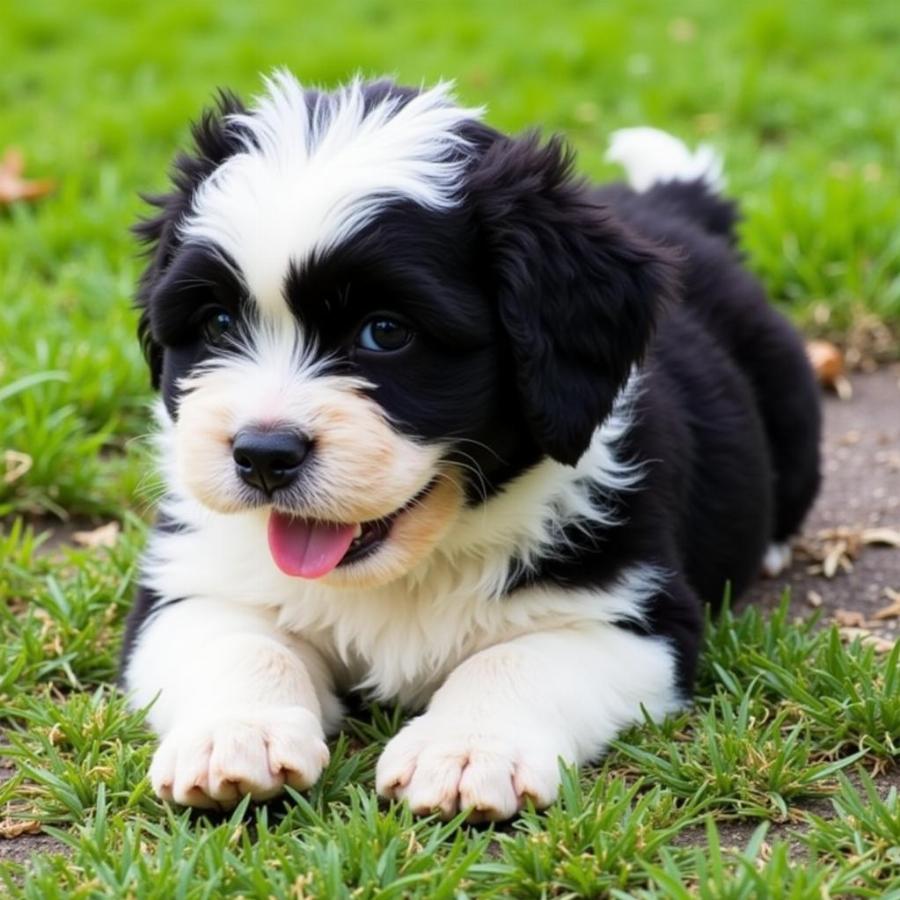The black and white Lhasa Apso dog, with its dramatic coat and captivating personality, is a truly unique variation of this ancient Tibetan breed. While the traditional Lhasa Apso comes in a range of colors, the black and white version holds a special appeal for many dog lovers. This comprehensive guide will delve into everything you need to know about these beautiful companions, from their distinct appearance and temperament to their specific care requirements. Whether you’re considering welcoming a black and white Lhasa Apso into your home or simply curious about this fascinating breed, you’ll find valuable insights here.
Understanding the Black and White Lhasa Apso
The black and white coat pattern on a Lhasa Apso is a result of specific genetic combinations. While less common than other color variations like gold, cream, or parti-color, the stark contrast of black and white creates a truly striking appearance. But beyond their beautiful coat, black and white Lhasa Apsos share the same core characteristics as their counterparts. These small but sturdy dogs are known for their intelligence, independence, and loyal nature. They were originally bred as watchdogs in Tibetan monasteries, and this heritage contributes to their alert and sometimes wary disposition towards strangers.
 Black and White Lhasa Apso Puppy Playing
Black and White Lhasa Apso Puppy Playing
Caring for Your Black and White Lhasa Apso: Grooming, Diet, and Exercise
The luxurious coat of a black and white Lhasa Apso requires regular grooming to prevent matting and tangles. Daily brushing is recommended, especially for show dogs. Regular baths are also essential, and using a high-quality dog shampoo can help maintain the vibrancy of their black and white coat.
Just like other Lhasa Apsos, the black and white variety thrives on a balanced diet formulated for small breeds. High-quality kibble or wet food can provide the necessary nutrients for their overall health and well-being. Portion control is crucial to prevent obesity, a common issue in small dogs.
While not overly demanding in terms of exercise, black and white Lhasa Apsos still require regular physical activity. Daily walks and playtime are essential for their physical and mental stimulation.
Is a Black and White Lhasa Apso Right for You?
Black and white Lhasa Apsos can make wonderful companions for the right owners. They are intelligent and can be trained with patience and consistency. Their independent nature means they can be left alone for reasonable periods, but they also thrive on human interaction and affection. However, their wariness of strangers can sometimes lead to barking, so early socialization is crucial.
Training Your Black and White Lhasa Apso
Training a black and white Lhasa Apso requires patience and positive reinforcement. They can be independent and sometimes stubborn, so using rewards and praise will yield better results than harsh corrections. Early socialization is key to helping them develop into well-adjusted adults. Expose them to a variety of people, places, and situations from a young age to reduce their natural wariness.
Common Health Concerns in Black and White Lhasa Apsos
Like all breeds, black and white Lhasa Apsos can be prone to certain health conditions. Progressive Retinal Atrophy (PRA), cherry eye, and skin allergies are some of the issues that can affect this breed. Choosing a reputable breeder who screens their dogs for these conditions can significantly reduce the risk.
Conclusion: The Allure of the Black and White Lhasa Apso
The black and white Lhasa Apso dog offers a unique combination of beauty and personality. With their striking coat, loyal nature, and intelligent minds, these dogs can bring joy and companionship to the right homes. By understanding their specific needs and providing proper care, you can ensure a long and happy life for your black and white Lhasa Apso companion.
FAQ:
- Are black and white Lhasa Apsos rare? Yes, they are less common than other color variations.
- Do they shed a lot? They have a long, dense coat, but are considered low-shedding.
- Are they good with children? They can be good with children if properly socialized.
- Are they easy to train? They can be independent, so training requires patience and consistency.
- How long do they live? On average, they live for 12-15 years.
- What is their ideal weight? They typically weigh between 12-18 pounds.
- Are they hypoallergenic? No breed is truly hypoallergenic, but Lhasa Apsos are considered low-shedding.
Beaut Dogs is your trusted source for all things related to dog breeds. We offer comprehensive information on breed characteristics, care, and more. For any questions or further assistance, please contact us at Email: [email protected]. Beaut Dogs is committed to helping you find the perfect canine companion and provide the best possible care. Visit https://beautdogs.com today to learn more!